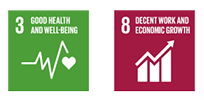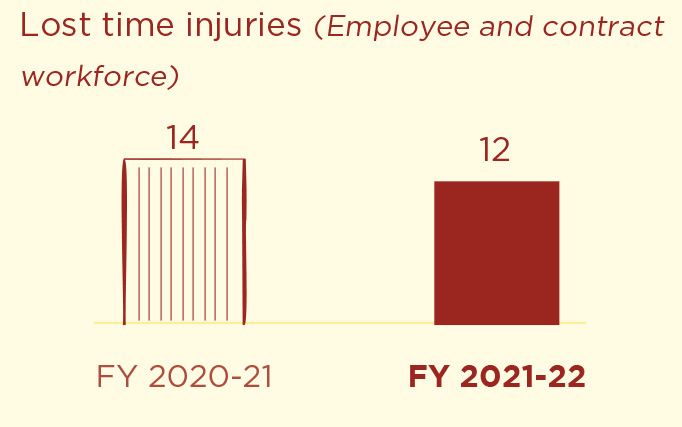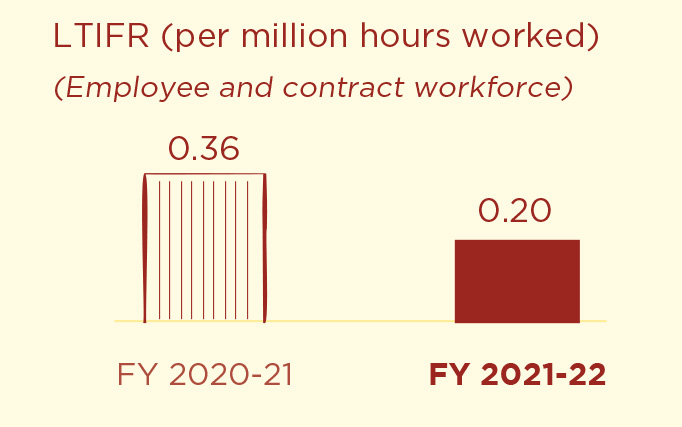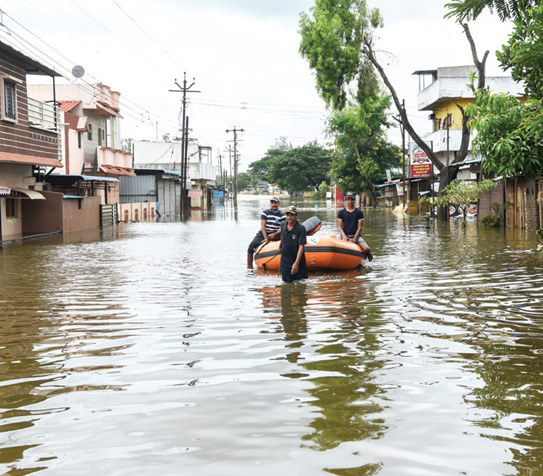Safety is at the core of facilitating enhanced workforce productivity, which culminates in improved operational efficiencies. Our approach to Occupational health and safety focuses on proactive strategies that foster our vision of creating a zero-harm work environment.


We are focussed on inculcating a safety-centric mindset in our workforce. The success of our Health and Safety (H&S) management systems and capacity-building programmes depends on our employees’ ability to put this mindset into action while carrying out daily operations. At Tata Communications, we aim to eliminate or reduce the impacts and risks associated with our operations, including all employees (including employees who are participating as sub-contractors) and other interested parties, through our H&S management systems. Our H&S management system is based on the Tata Group Safety Principles, ensuring that our operations are relevant and compliant with local laws and regulations.
Occupational health
Although occupational health is not identified as a key material issue, we have designed all our facilities with ergonomic comfort, safety, and security of our workforce in mind. At Tata Communications, we make sure that every workplace is hazard-free and maintains a healthy and conducive work environment by providing proper illumination, low noise levels, good ventilation systems, and hygienic food and water. Our facilities are equipped with medical rooms, rest rooms, pantry, break areas and sports facilities, and provide visiting doctors’ services. Being considered a labour-intensive company, we also focus on identifying risks and hazards associated with our contract workforce carrying out our field operational activities in comparison to managerial staff. As we take most of our international operational activities as planned activities, we consider health and safety management as a material issue, primarily in the Indian context.
H&S Management System Implementation
We successfully developed our management system, based on the Tata Group Health and Safety Management System and ISO 45001 Standard requirements. Last year, we successfully completed the ISO 45001:2018 certification audits for 10 of our major facilities (71%) in India
71%
of our major facilities in India
certified ISO 45001:2018
We are adding few more facilities this year to the ISO 45001 scope and are working to integrate with ISO 14001:2015. In total, 12 of our facilities in India are ISO 45001 certified. Furthermore, internationally two of our facilities in Singapore and three in Canada and our Australian operations got certified to ISO 45001 in FY 2021-22.
At Tata Communications, we have already defined organisational structure, responsibilities, procedures, processes, and resources for developing, implementing, achieving, reviewing, and maintaining the organisation’s OH&S policy and other commitments as a part of management system implementation. Our Global Safety Council (GSC) and Management Review Committee reviews the safety performance periodically. This year we have further added a Board level management committee (CSR, Safety and Sustainability Committee) to further strengthen the review mechanism and oversee the progress of business sustainability and aspects related to occupational health and safety (OHS). Our H&S management system has led us to eliminate or minimise the impacts and risks and explore new opportunities in our operational activities and services, cover all our employees (including employees engaged by the sub-contractors), and other interested parties like visitors and neighbouring communities and stakeholders. Our system is an effective mechanism for our contract workforce to identify and report hazards along with a free and informed consultation and participation process.
Safety: A key focus area
Workplace safety | Fire and health safety Electrical safety | Road and employee transport safety | Height safety | Confined area safety
At Tata Communications we regularly perform safety audits, inspections and assessments of offices and field operation sites, through effective engagement with our business managers and vendor partners of field operations, allowing us to identify key safety hazards, risks and workers in the high-risk category. We have adopted a multifaceted approach toward safety management, wherein all non-routine and routine high-risk activities are governed properly. Our Work Permit (WP) programme governs all our non-routine high-risk activities like façade cleaning, project work, lift maintenance, hot work and confined space work. In addition, we also have Mandatory Safety Standards (MSS), since 2016, that govern our routine high-risk activities like working at height for wireless work on tower/mast, maintenance work, and fibre restoration, etc.
Towards zero harm
We firmly believe that achieving ‘Zero Harm’ is possible if we all strive for it. Work safety remains a condition of employment at Tata Communications; a condition of engagement for all contractors and subcontractors, looking at it is as a mandate. We always record, report, investigate, and learn from incidents that are fundamental to our operations, and we do not accept any deviation from them. On-the-job training is also one of the key aspects through which we drive our safety culture within. We have developed an Incident Reporting System to report all the lead and lag incidents/ occurrences. This incident report system has well-laid procedures for reporting incidents, investigation, and the determination of corrective actions and improvements along with a no-reprisal mechanism for employees and the contract workforce.
Our health and safety performance
The health and safety of all employers and contractors is our top priority. This year, our employees and contractors reported 665 safety observations (1,484 in FY 2020-21). To ensure such ongoing improvement, the safety SPOCs carry out internal and external audits to suggest how technology, processes and behavioural safety can be best achieved. As a critical element of this ongoing focus, over 49,389 participants were trained in a total of 6,071 training sessions in FY 2021-22.
6,071
Training sessions
There has been an overall 9% decrease in the lost time injury rate (0.20 in FY 2021-22), calculated per million hours worked. Fortunately, none of these are serious injuries (disability, fatality, multiple fractures, etc.). Increased incident rate doesn’t necessarily mean increased safety risk on the ground, it also indicates an increased awareness level among ground staff. We will continue to focus upon increasing awareness on both Occupational and Safety related aspects for both our employees and contract workforce.
Safety statistics



Audit programme
To make our facilities as safe as possible, we have developed an audit programme that combines external and internal audits. This regularly assesses and mitigates any risks to health and safety. This year we conducted 817 mandatory safety standards audits, and a total of 15,401 audits were conducted by the Business Units (BU) and Environment Occupational Health and Safety (EOHS) team, wherein 100% of the audit findings have been closed by the end of the reporting year.
Technology-enabled safety
We leverage technology and follow various standards to address issues related to health and safety at the workplace. We have developed several IT-based solutions to ensure H&S compliance in our facilities:

E-Permit to Work (PTW) tool
All high-risk activities in our facilities are conducted with a valid online e-permit. The initiative was further cascaded to field operation teams last year. This year all wireline (fibre) and wireless team activities are now undertaken only with a valid work permit through e-PTW mobile app and the web portal.

E-safety passport for contract workers
The safety passport is a repository to include required skills and training for our contract workforce and is issued once applicable trainings are received by the workforce. Without an e-safety passport, our staff is not permitted to work on the field.

Driver Behaviour Monitoring (DBM) in field operation vehicles
We have installed DBM devices in all field operation vehicles, which are used for fibre optic cable maintenance activity pan-India. The device and the related portal gives us all the required data on driver behaviour (such as over-speeding, harsh braking, sudden acceleration, long time driving without break, competent driving, etc.), which has helped us reduce over-speeding violations significantly.

Campus safety
We monitor over-speeding cases within the campus through ASDS (Automatic Speed Detection System). The deployment of ASDS at Dighi Campus, Pune has helped ensure campus safety.

Resustain tool
It is an automated solution that aids our business and corporate environment, occupational health, and safety (EOHS) teams to automate HSE programmes, including incident reporting and investigation, audit management, reward and recognition, and MIS system for our Company.

Online work permit (iPad tool)
For international operations, we have developed an iPad tool to support the work permit programme and ensure that hazardous activities (working at height, electrical, etc.) at the facilities are undertaken with a valid work permit. We have currently deployed this technology in the US, Canada, and UK regions. We implement all HSE programmes, including work permits, through this iPad tool, and are also available under the common (SharePoint) platform. This tool turned out to be successful and has led to a reduction in safety hazards, and improved safe operations over the years. This year, we issued more than 1,000 work permits to carry out various high-risk activities safely.

Two-wheeler safety app developed for TCPSL ATM officers
We developed the two-wheeler safety app, to provide a governance mechanism, ensuring proper adherence to the safety measures, and in turn, overall safety risk reduction. The app monitors over-speeding, distance travelled, and PPE usage. The use of the app has ensured a 75%+ drop in speed burst.
Spearheading rescue operations
In July 2021, the state of Maharashtra experienced incessant rains and flooding. Amid this crisis, our Global Emergency Response Center (GERC) received an urgent evacuation assistance call from one of our employees, residing at Chiplun. Her family of 4 needed to be rescued as her residence had half-submerged in the floodwaters. In addition to this, they were also fast running out of essential resources, such as food and clean drinking water. In no time, our GERC team began formulating a rescue plan, looping in our emergency assistance partner - International SOS, and Regional Security Manager, while simultaneously coordinating with National Disaster Response Force (NDRF), in addition to an emergency rescue team created by our colleagues at Tata Motors (CSR). Our team also reached out to a rescue club from Ratnagiri to assist us better. Despite the adverse weather conditions, floods, and poor communication services, our team reached the location and rescued the family. The team also provided them with some food and clean drinking water, and helped clean the house as about 2 feet of sludge had accumulated indoors.

Despite the adverse weather conditions, floods, and poor communication services, our team reached the location and rescued the family.
Stretch and pause application
We have developed the ‘Stretch and Pause’ application, in accordance with industry-accepted human factors, office ergonomics guidelines, and international best practices, to maintain the health of our employees, working from home and office. This application is installed on Company laptops at the back end by the IT team. The app was mainly designed to give timely alerts to employees reminding them to stretch their body parts, drink fluids and relax for a few seconds. It addressed the ergonomic/stretching aspects, including eye strain management, hand strain management, spine/back freeze management, leg strain management, and wrist strain management.
Some key features of the app were:


Other initiatives

Management of change
The management of change template was released to identify the risks introduced into the system as a result of any major changes in manpower, technology, equipment, processes, machines, and so on. This procedure assisted us in identifying risks and mitigating measures before they were introduced into the system. The identified mitigation measures are linked to H&S management system documents, such as HIRA, SOPs, competency mapping, training calendars, legal registers, and so on.

ISO45001 lead auditor training
We identified a few key stakeholders, who are responsible for implementing and maintaining our organisation’s Health and Safety Management system, so we scheduled multiple sessions of ISO45001 lead auditor trainings, as part of cross-functional capability building. We now have a pool of approximately 30+ ISO45001 certified lead auditor staff, which will improve the effectiveness of internal audits.

New training partner for ‘work at height’ training
In addition to the existing two training providers (Karam and Force tech), we have identified another training partner through proper content validation, trainer profile reviews, and by conducting pilot training sessions for practical assessment and thereby approved M/s Safe Rescue, as a TCL approved training partner for ‘work at height’ training programmes.

Engagements with contractor workforce
We communicate with our contractor workforce through a variety of channels. Consultation and participation are important mechanisms in contractor workforce engagement. This clause is heavily emphasised in ISO45001. We have included this requirement as a target in all business function objectives and target sheets, and we are monitoring it quarterly. As part of the same, BU team consults with the contractor workforce about the H&S management system, and solicits feedback in order to improve the system.